TOP 15 Embedded Software Development Tools - MOR Software
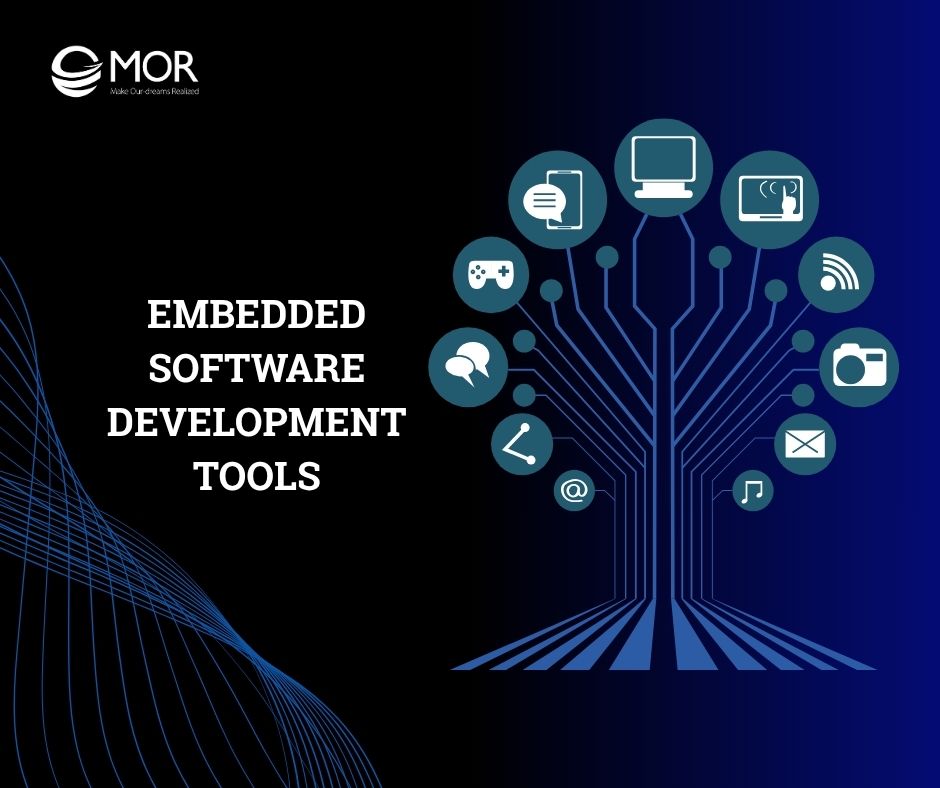
Are you looking to speed up your embedded systems development? What tools can help you achieve faster and more efficient results? Embedded software development tools are essential for optimizing the development process. In this MOR Company's article, we explore the top 15 tools that can significantly boost your project timelines, ensuring you meet deadlines with ease.
What Are Embedded Software Development Tools?
Embedded software development tools are specialized software solutions designed for creating, testing, and debugging embedded systems. Embedded systems are devices or products that use computer hardware and software but are not general-purpose computers. Examples include medical devices, automotive systems, industrial machines, and IoT devices.
The fundamental distinction between desktop and embedded programming centers on their intended function. Traditional desktop computers are designed for versatility and running a wide range of applications, allowing their software to be easily installed, updated, and reconfigured across many devices.
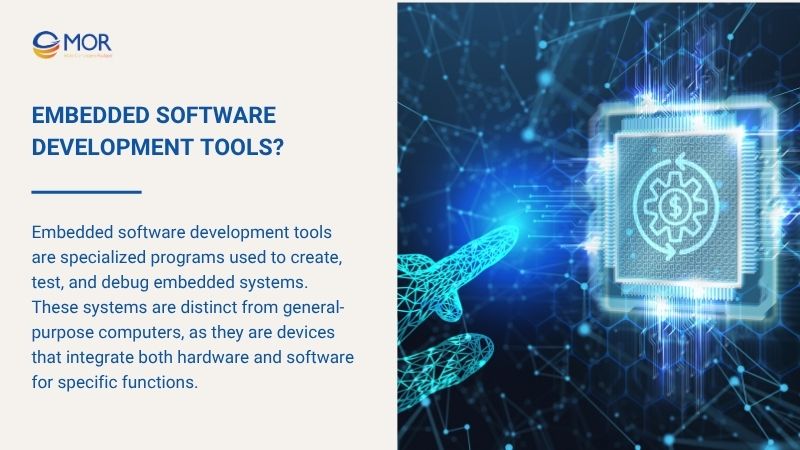
In contrast, automotive embedded systems are highly specialized, dedicated to performing a singular function for the specific hardware it controls. Developers must also consider crucial environmental factors—such as temperature or humidity—that could impact the device and its performance.
An embedded system itself is an integrated unit, combining essential hardware and software modules.
Hardware Assembly Components Include:
- A dedicated power supply.
- A SoM (System-on-a-Module) or SoC (System-on-a-Chip), which integrates microprocessors, memory, I/O, and peripherals onto one compact board.
Software Development Elements Require:
- Specialized Operating Systems (e.g., Yocto Linux, Windows CE, ThreadX, Nucleus RTOS).
- Programming Languages (commonly C, C++, Python, or JavaScript).
- Development Tools such as Integrated Development Environments (IDEs), Platform Development Kits (PDKs), Software Development Kits (SDKs), compiler toolchains, and hardware/software debuggers (like ST-Link or Segger).
Types of Embedded Software Development Tools
To effectively develop, debug, and manage complex embedded systems, engineers rely on a diverse set of specialized tools. These categories range from integrated environments that facilitate coding across platforms to real-time operating systems crucial for task management, and low-level tools essential for direct hardware interaction and debugging. The following sections detail the essential types of tools that drive modern embedded software projects.
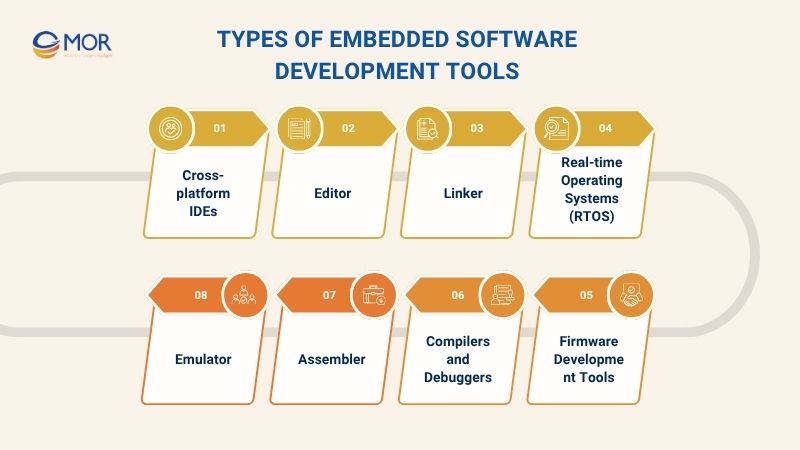
Cross-platform IDEs
Cross-platform Integrated Development Environments (IDEs) enable developers to write, test, and debug code across different operating systems like Windows, Linux, and macOS. These IDEs typically support multiple programming languages such as C, C++, Python, and JavaScript, making them versatile for various embedded development projects.
Examples:
- Eclipse: A widely used IDE, Eclipse is highly extensible and offers support for embedded development with plugins for different programming languages and processors. Its debugging features and ease of integration with version control systems make it an excellent choice for embedded developers.
Editor
The foundational instrument for initiating the development of any embedded system is a text editor. This tool is vital for composing the source code—typically written in languages like C and C++—which is then stored as a standard text file.
A strong, practical illustration of this is Geany. Known for being a lightweight and compact development environment, Geany leverages the GTK+ toolkit. It offers broad language support, handling files for C, Java, Python, HTML, PHP, Perl, Pascal, and numerous others.
Key features that make Geany an effective coding solution include:
- Syntax highlighting for improved readability.
- Code folding to manage and collapse large code blocks.
- Symbol name auto-completion to speed up writing.
- Snippets for quickly inserting common code structures.
- Automatic closing of XML and HTML tags.
- Efficient code navigation capabilities.
Example:
To start an IoT embedded software development, the very first requirement is a text editor. This is where developers craft the source code in languages like C or C++ before saving it. Geany, for instance, is a popular, lightweight editor that supports features essential for efficient coding, such as syntax highlighting and code auto-completion.
Linker
It's common practice to develop complex code in smaller, manageable files and modules. A linker serves as the vital utility that takes all these separate components and merges them, successfully producing one cohesive, functional, and executable program. A well-known example of this tool is GNU ld.
Real-time Operating Systems (RTOS)
An RTOS is a key component in embedded software development, especially when designing systems that require real-time performance, such as automotive systems or medical devices. RTOS provides multitasking, resource management, and prioritization of tasks to meet strict timing requirements.
Key Features of RTOS:
- Task scheduling and management
- Low-latency operation
- Multi-threading support
- Real-time task prioritization
Examples:
- FreeRTOS: One of the most popular open-source RTOS for embedded systems, FreeRTOS is widely used in embedded software development tools for IoT devices. It provides excellent support for ARM Cortex-M microcontrollers, making it a top choice for developers working on IoT projects that require real-time data processing and management.
Firmware Development Tools
Firmware development tools allow developers to write low-level software that directly interacts with the hardware. These tools are essential for debugging and testing embedded firmware.
Importance of Firmware Debugging:
- Identifies low-level issues in embedded systems.
- Enables real-time testing on hardware.
Popular Tools:
- JTAG: A standard for debugging and programming embedded development software, JTAG (Joint Test Action Group) interfaces with hardware to test and debug chips and devices directly.
- OpenOCD: An open-source tool for debugging embedded systems via JTAG or SWD interfaces, OpenOCD is widely used for low-level debugging.
Additionally, open source embedded systems programming tools like OpenOCD provide flexible, customizable solutions, allowing developers to modify the tools to meet specific project needs, which can significantly streamline the debugging process.
Compilers and Debuggers
Compilers are essential for converting source code into machine-readable code. Debuggers allow developers to step through their code to identify and fix issues.
Role in the Development Process:
- Compilers convert high-level fastest programming languages like C or C++ into low-level machine code that can run on embedded devices.
- Debuggers identify bugs and allow developers to fix issues in the software or firmware.
Top Compilers and Debuggers:
- GNU Compiler Collection (GCC): The GCC is an open-source compiler widely used for embedded development. It supports many architectures, including ARM, and is known for its performance optimization features.
- ARM Keil: A commercial suite of development tools designed for ARM-based embedded systems, Keil offers compilers, debuggers, and simulation tools tailored to ARM processors.
Assembler
The primary role of an assembler is to translate source code written by a programmer into the machine code that a computer's processor can execute. Unlike a compiler, which typically performs this conversion in a single, direct step, an assembler operates in two stages: it first transforms the source code into object code, which is then subsequently converted into the final machine language.
A prominent example of this tool is the GNU Assembler (GAS). It sees widespread use within Linux environments and is also a standard component included in the Macintosh development tools package.
Emulator
An emulator provides an exact digital replica of the target hardware, mirroring its functions and internal architecture. This crucial tool allows developers to simulate the software's performance and observe precisely how the code will behave in a real-time environment. By using an emulator, programmers can adjust variables and settings to optimize the code for ideal performance before the final, validated software is permanently integrated (embedded) into the physical device.
Review Top Embedded Software Development Tools
To streamline the complex process of coding, debugging, and managing embedded projects, developers rely on powerful, purpose-built Integrated Development Environments (IDEs). These tools offer comprehensive feature sets, often including specialized compilers, debuggers, and support for various microcontrollers and architectures. The following are some of the top-tier IDEs and development toolchains widely adopted in the embedded software industry.
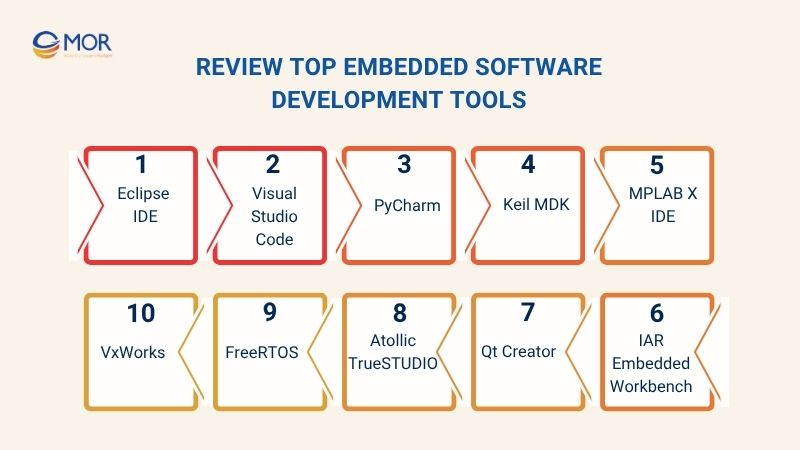
Eclipse IDE
Eclipse is a popular, open-source IDE for embedded systems development. It is highly customizable, supporting a wide range of programming languages and platforms, including C/C++, Python, and Java. Eclipse is particularly useful for projects that require cross-compilation and integration with other tools.
Visual Studio Code
VS Code is a lightweight embedded software IDE for ARM processors, fast, and flexible, perfect for embedded development. It supports many programming languages and provides a user-friendly interface, making it ideal for both beginners and advanced developers working on embedded systems.
PyCharm
For Python-based embedded systems, PyCharm offers advanced debugging features, intelligent code completion, and remote development. It’s perfect for IoT projects where Python is used for scripting or managing device communications.
Keil MDK
Keil MDK is a comprehensive IDE designed specifically for ARM-based microcontrollers. It includes C/C++ compilers, debuggers, and real-time operating system support, making it one of the best choices for embedded developers working with ARM Cortex processors.
Embedded C programming is one of the primary languages used in Keil MDK, and it provides excellent tools for optimizing performance, reducing memory usage, and ensuring that the application runs efficiently on resource-constrained embedded systems.
MPLAB X IDE
MPLAB X IDE by Microchip Technology is an open-source IDE that supports development for PIC microcontrollers and Digital Signal Controllers. It provides integrated debugging, code editing, and project management, making it ideal for hardware-specific embedded software projects.
Texas Instruments also provides excellent development tools that complement MPLAB X, allowing developers to integrate their products seamlessly with TI’s microcontrollers and DSPs, offering an additional layer of flexibility and performance in embedded systems.
IAR Embedded Workbench
IAR Embedded Workbench is an efficient tool for creating embedded applications for various microcontrollers. It includes powerful debugging capabilities, real-time analysis, and support for a wide range of architectures, including ARM, AVR, and MSP430.
Serial communication tools in IAR Embedded Workbench are invaluable for developers working with embedded systems that require serial data transmission, enabling easy debugging and data exchange between the embedded device and external systems.
Qt Creator
Qt Creator is perfect for embedded systems that require graphical user interfaces (GUIs). It supports C++ and QML, and it’s widely used in industries like automotive and consumer electronics where user-friendly interfaces are essential.
One of the key features of Qt Creator is its hardware abstraction layer (HAL), which simplifies the integration of the GUI with different hardware platforms. By using a HAL, developers can easily port their applications across various hardware platforms without needing to rewrite low-level code.
Atollic TrueSTUDIO
Designed for ARM Cortex-M microcontrollers, Atollic TrueSTUDIO provides advanced debugging capabilities, integrated hardware debugging, and real-time analysis tools, making it a solid choice for ARM-based embedded development.
FreeRTOS
An open-source RTOS, FreeRTOS is widely used for embedded systems, particularly in IoT devices. It is lightweight, reliable, and has a large developer community, offering features like task scheduling, multi-threading, and real-time task management.
VxWorks
VxWorks is a commercial RTOS used in high-reliability industries like aerospace and defense. It provides deterministic performance and advanced features for critical real-time applications, including multi-core processing, task scheduling, and network communication.
JTAG
JTAG is a standard for debugging embedded systems, allowing developers to directly interact with hardware and test the circuit boards. It is a must-have tool for hardware-level debugging. In particular, microcontroller debugging is greatly enhanced by JTAG, as it provides a direct interface to the microcontroller, enabling step-by-step debugging, memory inspection, and precise control over the system’s execution, which is essential for troubleshooting complex embedded systems.
OpenOCD
OpenOCD is an open-source tool that works with JTAG and SWD interfaces. It allows developers to access and debug low-level systems, making it an essential tool for firmware development. When working with new hardware platforms, board support package (BSP) integration in OpenOCD helps developers ensure compatibility and enables debugging and programming directly on the target board, making it easier to develop and test embedded systems.
GNU Compiler Collection (GCC)
The GCC is an open-source, cross-platform compiler widely used in embedded systems programming. It supports many architectures, including ARM, and offers excellent code optimization, making it ideal for resource-constrained embedded devices. Additionally, code profiling features in GCC help developers analyze the performance of their embedded applications, identify bottlenecks, and optimize code to improve execution speed and reduce memory usage, which is essential in embedded systems development.
ARM Keil
ARM Keil tools are designed specifically for ARM processors, including ARM Cortex. They include compilers, debuggers, and simulation tools that help embedded developers optimize their applications for ARM-based systems.
How To Choose The Best Embedded Software Development Tools?
Selecting the appropriate toolkit is a critical step in any embedded project. The optimal choice is determined by several interlocking factors, ensuring the tools align with the project's technical demands, financial constraints, and hardware requirements. The following criteria should be carefully evaluated when deciding on the best embedded software development tools.
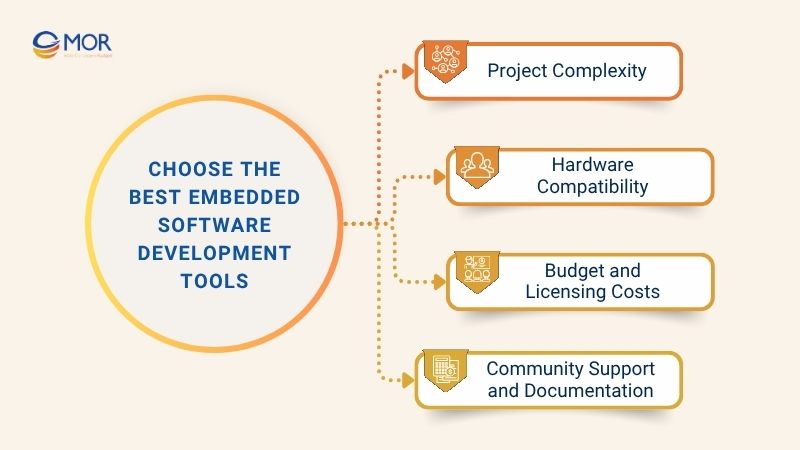
Project Complexity
The complexity of your embedded system project will heavily influence your choice of development tools. Simple applications might work well with basic IDEs and compilers, while more complex systems may require advanced debugging and real-time operating systems. In such cases, a comparison of real-time operating systems for embedded development is vital to identify which RTOS offers the best features and performance for handling complex tasks and timing constraints.
Hardware Compatibility
It’s crucial to ensure that your development tools are compatible with the hardware you're using. Whether you're working with ARM processors, microcontrollers from Microchip Technology, or NXP Semiconductors, choosing the right tools ensures seamless integration.
Budget and Licensing Costs
The cost of development tools can vary significantly. Open-source tools like FreeRTOS and GCC are budget-friendly, while commercial tools like ARM Keil may require a higher investment. Evaluate the tools' costs versus their benefits to your project.
Community Support and Documentation
Strong community support and comprehensive documentation are essential when troubleshooting or learning new tools. Platforms like Eclipse and VS Code have large communities, making them reliable choices for developers.
>>> Are you looking for the top embedded companies to develop your project in 2025? Highlight the top 10 companies in 2025, so you can make the right decision!
Best Practices for Using Embedded Software Development Tools
Proper Toolchain Setup
Setting up an efficient toolchain ensures that all components of your development environment work together seamlessly, improving productivity and reducing errors.
Efficient Debugging Strategies
Use advanced debugging techniques to catch errors early in the development cycle. Tools like JTAG and OpenOCD are invaluable for hardware-level debugging.
Importance of Continuous Integration (CI)
Integrating CI practices into your embedded development workflow ensures that code is tested and validated regularly, improving quality and reducing the time to market.
Leveraging Community and Professional Support
Don't hesitate to seek help from professional support or the online community when needed. Accessing resources such as forums, documentation, and expert guidance can significantly speed up the development process.
Conclusion
Choosing the right embedded software development tools is essential for the success of your embedded system projects. Whether you are developing for IoT devices, working with ARM processors, or building real-time systems, the tools you select will significantly impact your project's performance and efficiency. If you're looking for expert guidance in selecting and implementing the best embedded software tools, MOR Software JSC is here to help. Contact us today to streamline your development process and bring your embedded systems to life!
MOR SOFTWARE
Frequently Asked Questions (FAQs)
Which tools are used in embedded software development?
The first essential tool for embedded software development is a text editor, which allows developers to write source code in languages like C and C++ and save it as a text file. Popular examples include Geany, a lightweight and versatile editor built with the GTK+ toolkit, ideal for embedded programming.
Is Python or C++ better for embedded systems?
C++ is typically preferred for embedded systems due to its efficiency, speed, and precise control over hardware resources—making it suitable for low-level programming. Python, on the other hand, offers simplicity and faster development cycles, making it ideal for high-level or resource-rich embedded applications.
Do embedded systems use C or C++?
Most embedded systems are written in C, known for its efficiency and close-to-hardware control. However, C++ is increasingly favored for its object-oriented features, code reusability, and ability to manage complex embedded applications.
What is an embedded tool?
An embedded tool refers to hardware or software utilities used to design, program, test, and debug embedded systems. These systems combine software and hardware to perform specific tasks, often as part of larger devices like medical instruments, automotive systems, or industrial machines.
What are the four types of embedded systems?
Embedded systems are commonly categorized into four types based on performance and functionality:
- Real-time embedded systems
- Standalone embedded systems
- Networked (or distributed) embedded systems
- Mobile embedded systems
What is Ada programming?
Ada is a high-level programming language built for large-scale, safety-critical applications where reliability is vital—such as aerospace, air traffic control, and medical devices. It supports strong typing, modular design, real-time processing, and concurrency, helping developers detect and prevent software errors early in the development cycle.
What programming languages are used in embedded software?
The most common languages for embedded software are C and C++, known for their performance and hardware control. However, newer languages like Python and Rust are gaining traction for certain use cases, offering greater safety and productivity depending on project requirements.
What is embedded programming?
Embedded programming (or embedded coding) involves writing software for devices that perform dedicated functions within larger systems—like cars, appliances, medical tools, or industrial controllers. Developers must understand both hardware and software integration, often using C/C++ and real-time operating systems (RTOS) to ensure precise timing and reliability.
Rate this article
0
over 5.0 based on 0 reviews
Your rating on this news:
Name
*Email
*Write your comment
*Send your comment
1